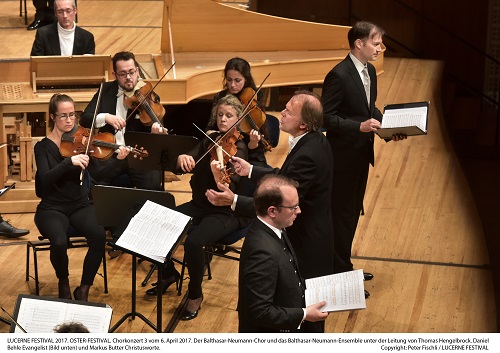 Switzerland Bach: Balthasar-Neumann-Ensemble, Balthasar-Neumann-Choir / Thomas Hengelbrock (conductor), Daniel Behle (tenor), Markus Butter (baritone) Kultur- und Kongresszentrum Luzern (KKL), Lucerne, 6.4.2017. (JR)
Switzerland Bach: Balthasar-Neumann-Ensemble, Balthasar-Neumann-Choir / Thomas Hengelbrock (conductor), Daniel Behle (tenor), Markus Butter (baritone) Kultur- und Kongresszentrum Luzern (KKL), Lucerne, 6.4.2017. (JR)

Bach – St. John Passion (Second Version 1725) BWV 245
At Easter, especially in still somewhat religious Central Europe, musical offerings turn to Passions, particularly Bach’s St. Matthew Passion and the slightly less popular St. John’s Passion, though there are also interesting and adventurous “modern” equivalents such as Frank Martin’s “Golgotha” being performed in Zurich over Easter.
Thomas Hengelbrock and the choir and ensemble he formed over 25 years ago brought to the conclusion of Lucerne’s Easter Festival Bach’s second version of the St. John Passion.
Bach had arrived in Leipzig in 1723 to take up the position of Music Director at the four main churches. He offered to compose cantata cycles for each Sunday service; a year later he composed the St. John Passion. John Eliot Gardiner writes, in his erudite tome on Bach, that this was to be “the jewel in the necklace of cantatas he had fashioned so far”. In the end, Bach wrote five Passion settings in all and left behind fragments of others. Gardiner is on record as saying he prefers the St. John to the St. Matthew. Bach revised the St. John four times eventually restoring his original version as the definitive one. Hengelbrock opted to perform the first revision, tailored for the Good Friday service in 1725. (The two parts of the Passion are meant to frame the sermon).
The two most important changes from the first version involve replacing the opening and closing of the Passion. In place of the striking chorus “Herr, unser Herrscher” the new version opens with more serene “O Mensch, bewein dein’ Sünde gross” which Bach later re-located to the St. Matthew Passion and in place of the original hymn-like ending, Bach substituted the chorale “Christe, du Lamm Gottes”, recycled from a 1723 cantata. Other changes include some new dialogue for the bass and a new aria “Zerschmettert mich” for tenor soloist. This all makes for interesting listening to those au fait with the original and most frequently performed and recorded version.
Hengelbrock’s forces are small; I counted 23 singers (plus the two main soloists). The role of the Evangelist was sung by young German tenor Daniel Behle, who sang Erik (Der fliegende Holländer) at the Frankfurt Opera a few years ago and sings David (Die Meistersinger) in Bayreuth this year. He has a strong voice; I would have liked more involvement with the role, I did not come away deeply affected by his portrayal. The same criticism could be levelled at Austrian baritone Markus Butter, strong in volume, but characterisation somewhat lacking. Several of the soloists from the choir were considerably more involved in the “action”.
Pilate, for example, was impressively sung from a side balcony by Manfred Bittner and was chilling. One of the male altos in the choir, Carlos Mena, was indisposed; his stand-in Matthias Lucht sang competently but with little warmth; Anne Bierwirth, the second substitute, fared much better with her aria “Es ist vollbracht” full of pathos.
I was particularly impressed with both voice and acting skills of tenor Hermann Oswald who brought the work to life in his aria “Zerschmettert mich”.
The choir were excellent, spot-on entries (including those tricky “Wohin?” interjections) and blended chorales; they sang with conviction and verve, though surprisingly many followed the words of the chorales from the score. I could not fail to notice that one soprano, Katja Stuber, was blind. I could see her score appeared to be blank pages but her hand was following the braille. She sang a short aria “Zerfliesse, mein Herz” most beautifully, her crystalline soprano floating into the hall. My heart nearly dissolved into tears.
The orchestra were spirited and fully committed, especially the second cellist, and in full command of their tricky period instruments. “Gut gemacht” (“well done”) Hengelbrock mouthed as he left the stage at the end. Hengelbrock has hit the limelight recently as Music Director of the newly renamed NDR Elbphilharmonie Orchestra (formerly North German Radio Symphony Orchestra) due to the opening of their magnificent new concert hall in Hamburg. Their opening concert was a mixed programme to keep everyone including German Federal Chancellor Angela Merkel happy; he is however perhaps best known for his baroque repertoire at which he excels. He held the applause too long at the end of the Passion and one over-enthusiastic punter broke the spell.
One could argue that the Passions are more moving if performed in churches rather than vast concert halls that are more appropriate for large-scale works or possibly Passions with a chorus of a hundred. I was not overly affected by the performance and can only put that down to the acoustics rather than the quality of the singing. It was however klein aber fein (small but beautiful).
John Rhodes